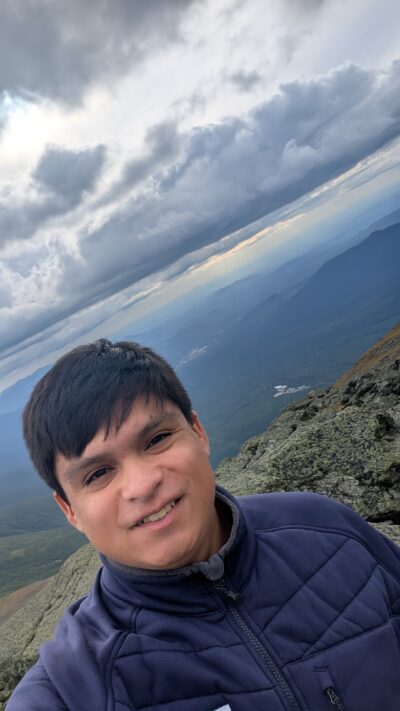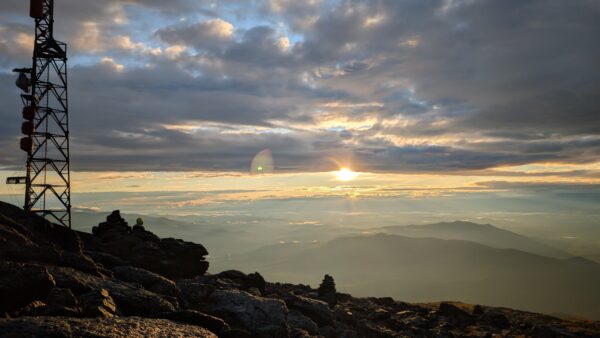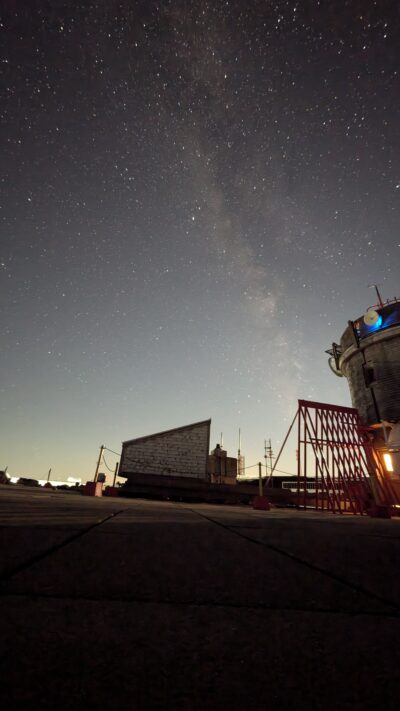Feeling the Winds of Opportunity at 6,288′ Feet
By Antonio Ruiz Núñez
Howdy! My name is Antonio Ruiz Núñez and I am one of the four interns here at the Mount Washington Observatory for the Fall 2025 season.

Taking a walk on another pleasant day here on the summit.
I was born and raised down in Houston, Texas. My interest and subsequent lifelong love for the weather started at a young age when Hurricane Rita made landfall in southeast Texas on my 5th birthday on September 24, 2005. I distinctly remember waking up in the middle of the night and being fascinated by hearing the wind rushing outside our home and seeing the rain fly by. From then on, I was interested in anything and everything related to the weather. As I grew up, I always kept tabs on the forecast from local TV meteorologists, kept track of hurricanes and their tracks manually on a map and maintained a personal weather station. My interest kept growing as I lived through various significant weather events such as Hurricane Ike (2008), Hurricane Harvey (2017), Tropical Storm Beta (2020) and the 2021 Texas freeze and the countless floods around Houston.
I went to Texas A&M University in College Station, Texas for my undergraduate studies. Following a stint in engineering, I switched my major into meteorology. This change in my life path allowed me to thrive like never before as it called upon my lifelong passion for weather and climate as I was able to learn more about the forecasting and research side of my passion. During my time in undergrad, I really enjoyed our practical weather forecasting class, all the very supportive professors and friends I got to meet and the NSF SOARS program which, simply put, changed my life. After a couple years in the program, I earned my Bachelor’s of Science in Meteorology in December 2024.
Following graduation, I was applying for graduate programs in Atmospheric Science and planned to start in Fall 2025. When I was unsuccessful, I looked for short-term opportunities to experience something new this Fall and enhance my skillset while I wait to enter grad school in Spring or Fall 2026. Lo and behold, I found the Mount Washington Observatory Internship program! I thought to myself: Why not take a chance and experience the world’s worst weather? Why not experience the coldest weather I have ever experienced? Why not be in an environment that is so foreign to what I am used to in Texas? So, I applied for the internship and I was very lucky to be selected! I immediately accepted and now here I am all the way in New Hampshire! A new experience filled with challenges, opportunity and responsibility await me these next 3 months. It is me throwing myself into a completely new environment very far away from home. I know that it will come with many unforeseen challenges but I am very excited to broaden my horizons, expand my skillset and enjoy this adventure!

A lovely sunset after my second full day on shift.
My research this fall will focus on determining how integrating the Mount Washington Regional Mesonet (MWRM) data into numerical weather prediction models (NWPs) affects the forecasting accuracy of mixed precipitation events for the Mount Washington region. Mixed precipitation events are notorious for being difficult to predict where exactly precipitation changes from rain to freezing rain to sleet to snow as any slight fluctuation in the vertical temperature profile can have big impacts on the precipitation type on the surface.
Currently, the MWRM data of current conditions on top of and around Mount Washington is not directly fed into numerical models such as the Global Forecast System (GFS), North American Mesoscale Model (NAM), High-Resolution Rapid Refresh (HRRR) and European Centre for Medium-Range Weather Forecasts model (ECMWF). However, if I am able to prove that integrating the MWRM into NWPs improves the precision and accuracy these models have for this type of event, we can take steps to integrate the MWRM into NWPs and get more accurate forecasts for mixed precipitation events in the future.
To complete this project, I will select one case study where a mixed precipitation event occurred in and around Mount Washington. Once selected, I will create 2 new model runs: one without the MWRM data (as a control simulation) and one with the MWRM data. Then I will compare both model runs to see if there is any improvement in forecasting the location and intensity of mixed precipitation events. If time allows, I can expand the study and repeat the process for more mixed precipitation cases.
At the time of writing, I am finishing up my last full day of my first shift on top of Mount Washington. I will say it has been a lot to learn very quickly between learning how to do tours, learning how to produce all the different forecast products (higher summits forecast, 2 radio shows, morning radio call), finding where to start on my research project, dusting off my forecasting skills and learning how to live at 6,288 feet. But, it has been a wonderful first week up here and I am very much looking forward to the following weeks!
I really appreciate all the support Karl, Ryan K, Mike, Jay, Misha and the rest of the MWOBS team have given me throughout my first week here getting me up to speed. I look forward to spending more time with them in the coming weeks as well as meet more people on the team. I also look forward to meeting the other intern on my shift, Alyssa, who will start next week and introduce herself on this blog soon.
Being the furthest north and the furthest east I have ever been in my entire life will definitely bring new challenges. Though I am nervous to experience so many new things at once, I feel that it will make me grow exponentially professionally and personally. I feel that I will have an unforgettable time up here at the summit of Mount Washington in the Mount Washington Observatory and I am excited to have chosen to do this because “if you feel it, chase it!”

Low light pollution at the summit allows for spectacular astrophotography— Even with just your phone!
Supporter Spotlight: Ryan Shepard
Supporter Spotlight: Ryan Shepard By Ryan Shepard and Carissa Milliman Ever since I was a kid, living in Western New York and growing up with lake effect snow, I thought harsh weather was incredibly
Supporter Spotlight: Erik Rider
Supporter Spotlight: Erik Rider By Wendy Almeida For Erik Rider, supporting Mount Washington Observatory comes from a lifelong fascination with weather and how it shapes daily life. Growing up along the Massachusetts coast, he
An Autumn Above the Clouds on Mount Washington
An Autumn Above the Clouds on Mount Washington By Cassie Farnsworth I don’t know how many times in life you get to say “it was exactly what I hoped it would be,” but my


